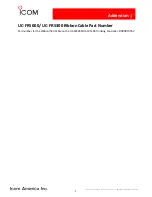
Cambridge Air Solutions.
40
M-Series Technical Manual
NOTE: This may need to be repeated several times to
record the above information. The LFS light on the
main PCB must remain off while setting the Low Fire
Start Voltage. If the LFS light energizes, turn the burner
service switch to the “OFF” position for 2 seconds then
back to the “LOCAL” position. Once the burner fires,
continue making your adjustments if necessary.
f. If adjustment is required, the Low Fire
Start adjustment screw (POT 1) is located
on the multi-functional PC board as
shown in the drawing below. Only minor
adjustments are normally required to
obtain the proper setting. To increase
the Low Fire Start voltage, turn POT1
clockwise. To decrease the Low Fire Start
voltage, turn POT1 counter clockwise.
9. CALCULATING AND ADJUSTING BURNER
MANIFOLD PRESSURE FOR HIGH SPEED
NOTE: The VFD should still be in “HAND” mode and
at 60Hz.
a. Turn the burner service switch to the
“OFF” position.
b. Disconnect wire #3 from the Maxitrol
amplifier to drive the modulating valve
to full open when the burner fires and the
low fire start sequence has ended.
c. Remove the 1/8" NPT plug from near the
manual shut-off valve located just prior
to the burner and connect a manometer
for the purpose of measuring the manifold
pressure. The manometer will need to be
able to read a negative pressure of up to
-2” WC.
d. Refer to the heater nameplate and
document the Manifold Differential
Pressure (MDP) (inch WC) for which the
heater was specified.
e. Verify the blower service switch is in the
“LOCAL” position.
f. Record the Manifold Static Pressure
measured on your manometer (Blower
Only).
g. Using the formula below, calculate the
required manifold pressure:
Nameplate Manifold Differential Pressure
___________” WC
+ Manifold Static Pressure (Blower Only)
___________” WC (Should Be A Negative Pressure)
= Calculated Manifold Pressure
___________” WC
NOTE: A negative manifold static pressure (blower
only) will cause the calculated manifold pressure reading
to be lower than the nameplate manifold differential
pressure.
IMPORTANT
The high limit may trip on warm or mild temperature
days. A jumper across the high limit may be necessary to
complete the manifold pressure adjustment.
h. Turn the burner service switch to the
“LOCAL” position. After a delay for pre-
purge and igniter warm-up, the burner will
light.
i. The burner will fire in low fire start. After
several seconds, the “LFS” light will
energize on the multifunctional PC board;
the burner will go into high fire.
j. Observe your manometer reading and
compare to the Calculated Manifold
Pressure above. If the manifold pressure
reading does not equal this value, adjust
the unit regulator until the proper manifold
pressure is obtained. The manifold
pressure is changed by adjusting the unit
regulator; White Rogers combination
valve (brass or silver cap), Maxitrol
RV53, Maxitrol RV61, Maxitrol RV81 or
Maxitrol MR212 valve (under dime size
cap).
IMPORTANT
The pressure drop across the burner profile damper that
was adjusted in Step 5 must not fall below 0.51 inches
WC for natural gas heaters without filters or 0.55 inches
WC for natural gas heaters with a filter section or filters
in the rain hood. The pressure drop must not fall below
0.75 inches WC for LP gas heaters without filters or
0.79 inches WC for LP gas heaters with a filter section
or filters in the rain hood. If the pressure drop is below
these values, it is an indication of low airflow or burner
over firing. To correct this condition, either adjust the
manifold pressure regulator to reduce the manifold
pressure or increase the blower speed, provided the
motor full load amps are not exceeded.
















































